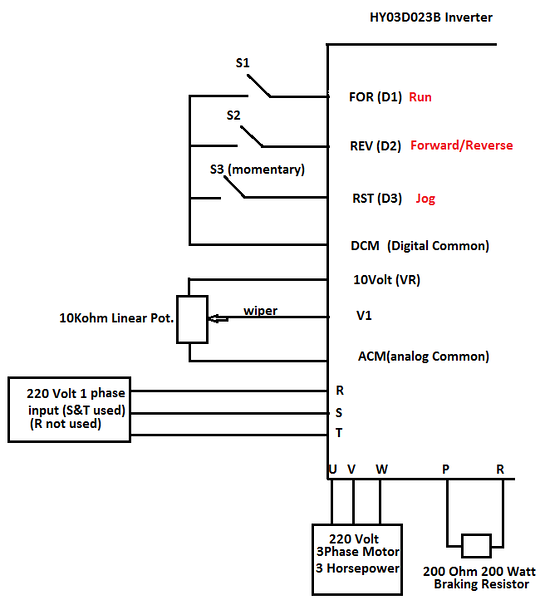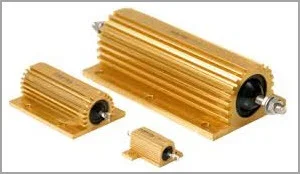I used a Hyanyang VFD on my 3hp 3 3 phase mill. The following is a post I wrote when I installed it a couple of years ago.
The Ferro mill is 220V 3 phase and my garage is only wired for 240V single phase so I installed a Hyanyang VFD on the mill and I am happy with the results. I have is set up with a remote panel with switches for run, forward/reverse and jog as well as a variable speed potentiometer. I removed the old electrical box from the side of the mill and gutted all the old electrical stuff out of it. I mounted the box on an adjustable pedestal with the vfd and switch panel inside so it can be reached easily. After I got all the settings right I wrote a up a document and drew a schematic in case anyone else wants this information. The switch panel in the picture is temporary. I plan to make something prettier later, I just wanted to get it up and running fast.




 Huanyang Inverter (VFD)
Huanyang Inverter (VFD)
-Model number
HY03D023B
-
Input 240 Volt single phase
-
Rated output 220 Volt 3 phase
4 HP or 3KW 13 Amps (220 volts X 13 Amps = 2860 watts) (1 HP = 746 Watts) (4 X 746 Watts = 2984 Watts)
Initial Set-Up
-Instructions from vendor (eBay seller “Solar Jean”) suggested the frequency parameters be
set in the following order:
PD05 set to 60HZ, PD04 set to 60HZ, PD03 set to 60HZ, PD72 to 60HZ. I connected the 200 Volt single phase input power to terminals S and T and the 3 legs of the 3 phase 3 HP motor to terminals U, V, and W. I plugged the VFD in with it temporarily just lying of the table of the mill and it powered up. I set the above parameters as suggested and the Run, Forward and Reverse functions worked from the unit’s built in keypad.
Advanced Set-Up
-I wanted to use a remote mounted control panel to allow remote function of Run, Forward/Reverse, Jog as well as a Potentiometer controlled variable speed. Since the mill has a variable speed head I see no reason to run the motor at more than the rated 60HZ. Using the supplied manual I then made the following switching, wiring and parameter changes to achieve the functions I wanted. I used the schematic on page 37 as a guide for the 3 wire Run, Forward/Reverse switches and the schematic on page 12 for the wiring of the Potentiometer. Page 36 explains how the output terminals can be re-configured for multiple uses. I drew the following schematic after researching the manual. The information on pages 19-26 of the manual details which parameters and settings support the different functions. Since my custom settings are all basic they are all covered on pages 19-20 except PD72 which was part of the initial setup for 60HZ power. These are the connections and parameter changes I made to make the VFD function as I wanted:
See the schematic Switch 1 is for D1, Switch 2 is for D2 and Switch 3 is for D3.
-
PD01 set to 1 to support use of external input controls.
-
PD44 set to 1 to change the function of the “FOR” terminal to D1. When set to 1, D1 is now the Run function.
-
PD45 set to 5 to change the function of the “REV” terminal to D2. When set to 5, D2 is now the Forward/Reverse selector. When Switch 2 is open you get forward rotation and when closed you get reverse. See page 37 of the manual for these instructions.
-
PD46 set to 6 to change the function of the “RST” terminal to D3. When set to 6, D3 is now the Jog function. It works in forward or reverse depending on the position of switch 2.
-
PD02 set to 1 to support the input from the external Potentiometer for speed control.
-
PD11 set to 10. This sets the lowest frequency of the variable speed to 10HZ so the potentiometer can adjust the speed of the motor from 10HZ to 60HZ. The factory setting is 0 so when the pot is turned all the way down the motor stops.
-
PD14 set to 5 to change the acceleration time (0Hz to 60HZ) to 5 seconds when run is selected. Factory setting is 20 seconds.
-
PD15 set to 5 to change ramp down or deceleration time (60HZ to 0HZ) to 5 seconds. I was cautioned to go no lower than 5 seconds without connecting an external braking resistor. The VFD must be given time to dissipate the energy created by the motor as it slows (it acts as a generator when slowing). The internal braking circuits in the VFD cannot support aggressive deceleration and an external braking resistor must be added to slow to a stop quickly.
Using the information in the manual, and some internet searches I settled on a 200 ohm, 200 watt resistor. I have ordered but not received it yet so the one show in the schematic is not wired in currently. I will update this information when I get the resistor and experiment with aggressive slow down times.
Finished product. Still working well after almost 2 years.



This is the braking resistor I installed.

John










